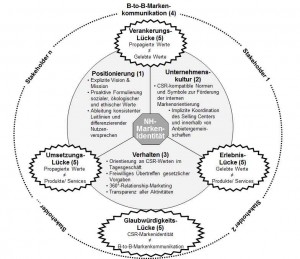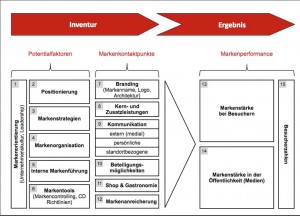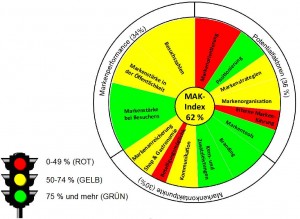Brand Co-Creation
Brand meaning no longer only emerges from decisions and their execution by brand management. Instead, stakeholders such as employees, partners and consumers participate in the process of shaping the brand. The so-called phenomenon of Co-Creation even occurs when brand management does not promote or even tries to hinder it. Social Media, collaboration tools as well as social change strengthen Brand Co-Creation. In this research project effects as well as the emergence of Co-Creation together with the „new“ tools necessary for brand management are being examined.
Selected Publications
- Baumgarth, C.; Kristal, S. (2015): „Die Mitmachmarke“ – Forschungsstand und Agenda Brand Co-Creation (BCC), in: transfer – Werbeforschung & Praxis, 61. Jg., H. 4, pp. 14-20.
- Kristal, S.; Baumgarth, C.; Behnke, C.; Henseler, J. (2016): Is co-creation really a booster for brand equity? The role of co-creation in observer-based brand equity (OBBE), in: Journal of Product and Brand Management, Vol. 25, No. 3, pp. 247-261.
- Kristal, S.; Baumgarth, C.; Henseler, J. (2018): „Brand play“ versus „Brand attack“: the subversion of brand meaning in non-collaborative co-creation by professional artists and consumer activists, in: Journal of Product & Brand Management, 27(3), pp. 334-347.
- Baumgarth, C.; Franzel, C.; Kristal, S. (2019): Ottobock – Transformation from a high-tech product to a co-created technology brand, in: Co-creating brands, Eds.: Ind, N.; Schmidt, H. J., London et al., pp. 234-248.
Techpoints and AI as Instruments of Brand Management
Digital technologies are of increasing relevance for brand management and brand research. Therefore the research team is working on a broad spectrum of topics such as Artificial Intelligence (AI), Augmented Reality (AR) and Computer-Generated Imagery Influencers (CGII) on Instagram. Furthermore we are testing new research methods such as Eye-Tracking, measuring emotion via Face Recognition, enabling AI-based data processing.
Selected Publications:
- Baumgarth, C.; Kirkby, A.; Lambrecht, A. (2020): Ende des KI-Marken-Winters: Künstliche Intelligenz in der Markenführung, in: Digitalisierung der Betriebswirtschaftslehre, Hrsg.: Pernsteiner, H.; Gögus, H. S.; Schöning, S., Wien, 1-36.
- Baumgarth, C. (2022): Soziale Roboter als Markenkontaktpunkte, in: Integriertes Online- und Offline-Channel-Marketing, Hrsg.: Butzer-Strozhmann, K., Wiesbaden, S. 191-207.
- Kirkby, A.; Baumgarth, C.; Henseler, J. (2023): To disclose or not disclose”: that is no longer the question. Effect of disclosing brand voice as AI-generated versus human-written on brand authenticity and attitude. Journal of Product & Brand Management, 32(7), 1108-1127.
Art and Branding
This research focus examines the mutual potential for art and management. Firstly, we are exploring how concepts and instruments from management and brand management can be used or adapted to promote the exchange relationships in the art and creative sector. Secondly, we want to find out how to use art as metaphor, technology, input or as a distinguishing mark for companies.
Selected Publications:
- Baumgarth, C.; Lohrisch, N.; Kastner, O. (2014): Arts meet luxury brands, in: The Management of Luxury, Eds.: Berghaus, B.; Mueller-Stewens, G.; Reinecke, S., London (in press).
- Baumgarth, C.; Sandberg, B.; Brunsen, H.; Schirm, A. (2014): Kunst-Unternehmens-Kooperationen (KUK) Begriffsbestimmung, Typologie und potentieller Nutzen, Berlin.
- Baumgarth, C.; Brunsen, H.; Lohrisch, N. (2014): KUK-Plattformen als Impulsgeber für Kunst-Unternehmens-Kooperationen (KUK), Berlin.
- Baumgarth, C.; Sandberg, B. (Hrsg.) (2016): Handbuch Kunst-Unternehmens-Kooperationen, Bielefeld.
- Baumgarth, C. (2018): Brand management and the world of the arts: collaboration, co-operation, co-creation and inspiration, in: Journal of Product & Brand Management, 27(3), pp. 237-248.
- Baumgarth, C (2020): Kunst gegen Leerstand und Tristesse – Urban Art Infusion-Effekt im Kontext der Einkaufscenter-Marke, in: Forum Markenforschung 2018, Hrsg.: Schmidt, H. J.; Baumgarth, C., Wiesbaden, pp. 195-212.
- Baumgarth, C.; Wieker, J. B. (2020): From the (fine) art to the urban art infusion effect – Replication and extension of the art infusion hypothesis, in: Creativity and Innovation Management (Online).
Brand (Orientation)
All in all the brand concept creates a point of orientation for the whole research conducted by the professorship of Marketing, especially Brand Management. Brand Orientation plays a key role in our research, which assumes in contrast to the classical brand or customer orientation that the brand or brand identity is the starting point of all strategic and operative decisions – rather than the partly scattered customer needs. To analyse brand orientation, a culture based model was developed which has been tested empirically in several industries.
Selected Publications:
- Baumgarth, C. (2007): Markenorientierung von Medien: Konzept, Ausprägungen und Erfolgsbeitrag am Beispiel von Fachzeitschriften, in: Medienwirtschaft, 4. Jg. (2007), H. 3, S. 6 – 17.
- Baumgarth, C. (2009): Brand Orientation of Museums: Model and Empirical Results, in: International Journal of Arts Management, Vol. 11, No. 3, pp. 30 – 45.
- Baumgarth, C. (2010): “Living the brand”: brand orientation in the business-to-business sector, in: European Journal of Marketing, Vol. 44, No. 5, pp. 653-671.
- Baumgarth, C.; Merrilees, B.; Urde, M. (2011): Kunden- oder Markenorientierung: Zwei Seiten einer Medaille oder alternative Routen?, in: Marketing Review St. Gallen, 28. Jg., H. 1, pp. 8 – 13.
- Urde, M.; Baumgarth, C.; Merrilees, B. (2013): Brand orientation and market orientation: From alternatives to synergy, in: Journal of Business Research, Vol. 66, No. 1, pp. 13-20.
- Baumgarth, C.; Merrilees, B.; Urde, M. (2013): Brand orientation: Past, present, and future, in: Journal of Marketing Management, Vol. 29. No. 9-10, pp. 973-980.
- Baumgarth, C. (2014): Markenpolitik – Markentheorien, Markenwirkungen, Markenführung, Markencontrolling, 4. Aufl., Wiesbaden.
- Lückenbach, F.; Baumgarth, C.; Schmidt, H. J., Henseler, J. (2019): To perform or not to perfom? How strategic orientations influence the performance of Social Entrepreneurship Organizations, in: cogent – business & management, 6, pp. 1-15.[/dropdown_box]
CSR-Marketing and Brands
Corporate Social Responsibility or sustainability are central and current topics in management- and marketing research and practice. This focus does not deal with the whole breadth of the topic. Instead it focusses on business models which are developing or have implemented sustainability as a point of differentiation. This means that at the core it is being analyzed wether and how brands with a sustainability oriented identity work. In this research project a model for CSR brand management was developed and has been applied in several industries (e.g. real estate economy, luxury goods).
Selected Publications:
- Baumgarth, C.; Binckebanck, L. (2011): CSR-Markenmanagement in der mittelständischen Bau- und Immobilienwirtschaft – Konzeptionelle Überlegungen und Best-Practice-Beispiele, in: Jahrbuch KMU-Forschung: Nachhaltigkeit in kleinen und mittleren Unternehmen, Hrsg.: Meyer, J.-A., Lohmar, pp. 335 – 365.
- Baumgarth, C.; Binckebanck, L. (2012): Glaubwürdige CSR-Kommunikation durch eine identitätsbasierte CSR-Markenführung: Forschungsstand und konzeptionelles Modell, in: UmweltWirtschaftsForum. 19. Jg., H. 3/4, pp. 199 -205.
- Baumgarth, C.; Binckebanck, L.; Behrendt, C.; Bostelmann, C. M. (2012): Nachhaltig luxuriös, in: Markenartikel, 74. Jg., H. 7, pp. 40 – 43.
- Baumgarth, C.; Binckebanck, L. (2014): Best Practices der CSR-Markenführung und -kommunikation, in: Sustainable Marketing Management, Hrsg.: Meffert, H.; Kirchgeorg, M.; Kenning, P., Wiesbaden, pp. 175-203.[/dropdown_box]
B-to-B Branding
So far in the science and practice dealing with branding, consumer goods have been occupying a major role. This research project extends this narrow view through a focus on B-to-B markets. Questions on the relevance and the value of branding in the B-to-B area for the purpose of internal entrenchment of the brand in B-to-B companies for the successful execution of marketing concepts as well as effects of brands on professional demand are at the core of this research.
Selected Publications:
- Baumgarth, C. (2008): Integrated model of Marketing Quality (MARKET-Q) in the B-to-B Sector, in: Journal of Business Market Management, Vol. 2, H. 1, pp. 41 – 57.
- Baumgarth, C. (2008): Integrated model of Marketing Quality (MARKET-Q) in the B-to-B Sector, in: Journal of Business Market Management, Vol. 2, H. 1, pp. 41 – 57.
- Baumgarth, C. (2010): “Living the brand”: brand orientation in the business-to-business sector, in: European Journal of Marketing, Vol. 44, No. 5, pp. 653 – 671.
- Baumgarth, C.; Schmidt, M. (2010): How strong is the business-to-business brand in the workforce? An empirically-tested model of ‘internal brand equity’ in a business-to-business setting, in: Industrial Marketing Management, Vol. 39, No. 5, pp.1250 – 1260.
- Baumgarth, C.; Binckebanck, L. (2011): Sales Force Impact on B-to-B Brand Equity: Conceptual framework and empirical test, in: Journal of Product and Brand Management, Vol. 20, No. 6, pp. 487 – 498.
- Baumgarth, C. (Hrsg.) (2018): B-to-B-Markenführung, 2. Aufl., Wiesbaden
Brand Management for Cultural Institutions
Cultural institutions such as theatre or museums are an important part of social systems and have been or are publicly financed in Germany. However, the pressure on cultural institutions with regards to „success on the visitor market“ is increasing due to shortening resources, an increase in alternative offers, changing consumer needs, etc. Therefore cultural institutions have started to consider or should consider modern management concepts. This research focus especially deals with the potential of the brand concept für cultural institutions: E.g. from 2012 until 2013 an extensive research project was realized, a brand audit for cultural institutions was developed and applied and a QuickCheck for self-evaluation was implemented.
Selected Publications:
- Baumgarth, C. (2011): Markenaudit für Kulturinstitutionen – Skizze eines Instruments zur Professionalisierung der Markenführung im Kultursektor, in: Kulturbranding III, Hrsg.: Höhne, S.; Bünsch, N.; Ziegler, R. P., Leipzig, pp. 161 – 179.
- Baumgarth, C.; Kaluza, M. (2012): Erfolgsfaktoren von Brand Communities im Kultursektor, in: Jahrbuch für Kulturmanagement – Zukunft Publikum, Hrsg.: Bekmeier-Feuerhahn, S. et al., Bielefeld, pp. 309-342.
- Baumgarth, C.; Kaluza, M.; Lohrisch, N. (2014): Markenaudit für Kulturinstitutionen, Wiesbaden.
Additional Research Focuses:
Co-Branding, Ingredient Branding, Luxury Brands , Personal Comunnication as Brand Communication, Media Brands, Empirical Master Techniques, Implicit and Biometrical Research Methods (e.g. Eye Tracking).



